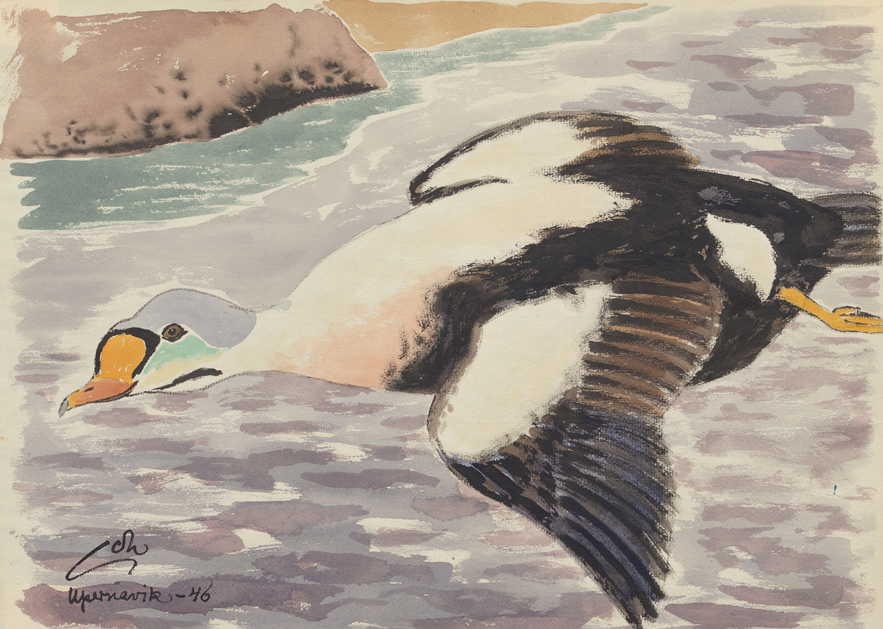The exhibition is called ”Aarsaarfimmi” and shows selected pieces by the artist Aage Gitz-Johansen (1897-1977). Aarsaarfimmi is the Greenlandic word for the place where a bird lands. Aarsaarpoq meaning the way a bird is hovering down. One of Gitz’s beloved motives was the birds – in air and landed. Following the line of Gitz, through his birds and women, brings forth what at times can seem like a flying mark in an effortless rhythm on the paper.
Trough repetition the artist can strive for the (im)possible perfection; to make the birds fly out of the paper; to make the women flawless in one stroke; to catch the lands sensuousness with color.
The artist traveled between Denmark and Greenland in the years of 1933 and 1948. He was called Qalipaasorsuaq (the big painter) and the Painter of Greenland. He voyaged at the same time as the painter Emanuel A. Petersen and the photographer Jette Bang, but while the others were seeking to document Greenland, Gitz was first and foremost inspired by Greenland.
The exhibition “Aaraarfimmi” examines birds, women, ornaments and the line in Gitz’s paintings from Greenland.
THE BIRD
Gitz was studying zoology before he was accepted at the school of graphics at the Academy of Fine Arts in Copenhagen. Birds not only as a repeated motive, but also an examination. This exhibition shows 20 original drawings from the book “Grønlands Fugle” (Birds of Greenland) published in 1950 with text by Finn Salomonsen. It took Gitz 17 years to draw the birds. They are drawn at their breeding grounds around Greenland, and depicted with a combination of close observations and knowledge about birds, combined with an artistic color interpretation of the landscape.
THE WOMEN
A sudden glimpse of youth, captured and caught – wrote the writer Ole Sarvig about Gitz’s woman. His images of women are at the same time a tribute and a loving embracement – both soft, round and lively – but also a man’s glance on something feminine. The naked women are looking away; we cannot catch their gaze. They are static, posing for the eyes of a masculine artist. They are not portraits, but more like studies; a shape and a complete stroke.
THE ORNAMENT
The lines of Gitz both twists and circles. Some calls it magic with lines. The ornament is playful, a contemplation and a repetition. The ornament is flirting with a meaning beyond itself; something symbolic, something bigger, deeper, wilder or something indigenous. This was sought by Gitz through his motifs drawn from Greenland, Lapland and Arabia.
THE LINE
The line of Gitz can seem to appear like calli- graphy. He captures the space between the lines and shapes it. He seems able to catch and master both birds and woman with one stroke. The line contains a carefulness and a feat; and in it is no luck. Gitz once said that art consists of 1% talent and 99% hard work.
The exhibition is supported by Kommuneqarfik Sermersooq, and includes pieces lent by The National Museum of Greenland, Galleri Roar Chsitiansen, Katuaq and Jeppe Gitz-Johansen.

